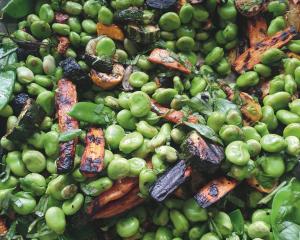
Of course it depends on really fine ingredients, Parmigiano (parmesan) from Italy and real balsamico, but food writer Faith Willinger describes herself as a power shopper as well as a born-again Italian.
Originally from New York, she went to Europe after a divorce in the early 1970s and was "blown away" by Italian cooking.
"I had been living in a country where the idea of Italian cooking was meatballs with spaghetti, veal scallopine, antipasto, clam sauce and panettone for dessert.
"Then all of a sudden there was risotto, polenta, raddichio, balsamico - I remember the first time I saw real mozzarella - I was used to the wrapped yellow stuff.
"I had an experience with parmigiano, I'd never heard of proscuitto. I was seeing all these amazing foods and I wanted to do something with them."
She wrote to Julia Child, the doyenne of French cooking in the US, sent her a packet of espresso to show she was serious, and asked advice. Child advised her to study with a professional.
In those days Italians were amused to find an American woman wanting to learn about Italian food, especially regional food.
Now every Italian restaurant worth its salt has a foreigner learning the cuisine, she says with a laugh.
After 35 years living and eating in Italy, and writing about it, she is a fount of information and inspiration on regional Italian food.
"In northern Puglia I found a tradition I thought pretty amazing. It was born of total poverty.
"You would harvest the wheat and burn the fields . . . and the poorest of the poor people would go through the fields and glean what was left of the burnt wheat, the leftovers.
"They would take it to a mill and it would be ground and used to stretch their regular flour when they made pasta so the pasta had a slightly smoky flavour. This is the kind of thing that becomes an acquired taste regionally."
She introduced the flour to a chef in a top northern Italian restaurant; he loved the flavour and now uses it in a creative way.
In one of her favourite family restaurants, Antiche Sapore, south of Naples, the owner took her into the field and picked zucchini tendrils and young shoot tips, blanched them in water, cooked pasta in the same water then dressed it with local olive oil and ricotta.
"We know about zucchini and some people know about the flowers which can be stuffed and eaten, but no-one knows about eating the tendrils," she said.
She likes to dress her salads with a peppery extra virgin olive oil and sea salt but no vinegar.
Good extra virgin olive oil has low acidity so why would you add acid, she asks.
She thinks we've been misled by many Italian recipes.
Many of us will be pleased to hear she uses water to make her risotto - most recipes call for hot stock but few of us have stock on hand, and you are making a broth as you go along, and if you've got really good vegetables and Parmegiano, you don't want the interference of the stock.
Now some chefs are also using water for risotto for the flavour, she said.
A traditional flavouring, that is now becoming fashionable overseas is wild fennel pollen.
Fennel often grows wild in waste spaces and you gather the flowers while they are yellow, before they develop into seeds, which we are more familiar with.
Hang them upside down to dry and then crumble and use it on meat, fish or vegetables and pasta or rice.
Its flavour is different from fennel seeds or leaves, and by report, it tastes a little like curry.
I'm certainly planning to try it when the fennel's in flower in spring.
Faith Willinger's fettunta (also known as bruschetta or garlic bread)
4 slices country-style bread sliced 1cm-2cm thick
1 garlic clove, unpeeled
1/2 cup or more of extra virgin olive oil
fine sea salt
freshly ground black pepper.
Toast or grill the bread slices until they are lightly coloured on both sides, Rub the garlic clove over the bread's surface.
The garlic will grate itself on the hardened toast and the peel disintegrates.
Garlic lovers should press hard.
Drizzle at least two tablespoons extra virgin olive oil (barely enough for any self-respecting Tuscan) over the toasted bread.
Sprinkle with salt and pepper and serve immediately.
Accompany with an assertive sauvignon blanc or a lightish red wine.
On the Net
For more information, check out faithwillinger.com - she recommends the recipe for garbage pail pasta on it.
Willinger's Red, White and Greens; The Italian way with vegetables (1996) is a regular on my kitchen bench for its wide selection of simple, useful recipes featuring vegetables.
She also has a new book out, Adventures of an Italian Food Lover (Clarkson Potter, $64).











